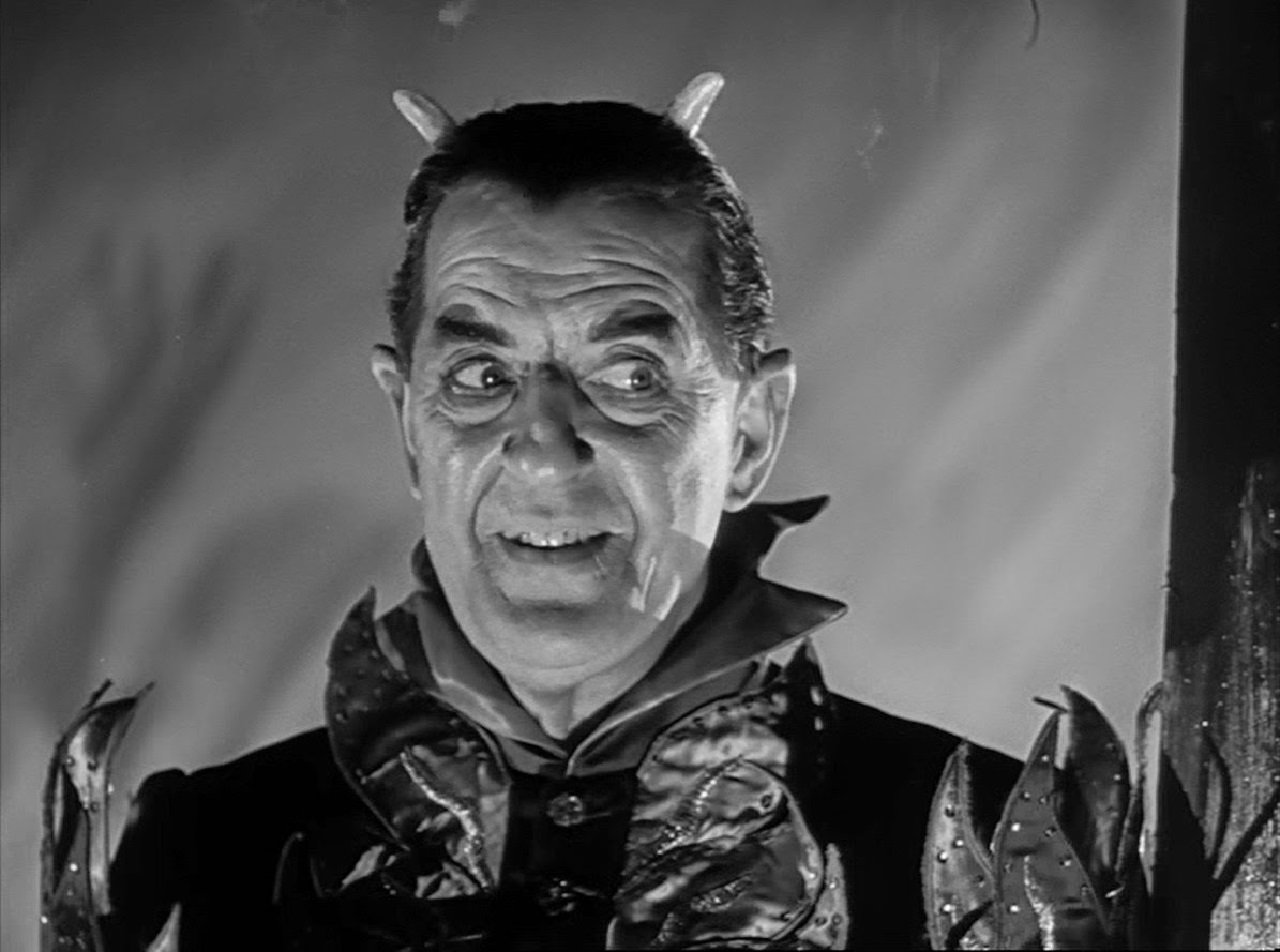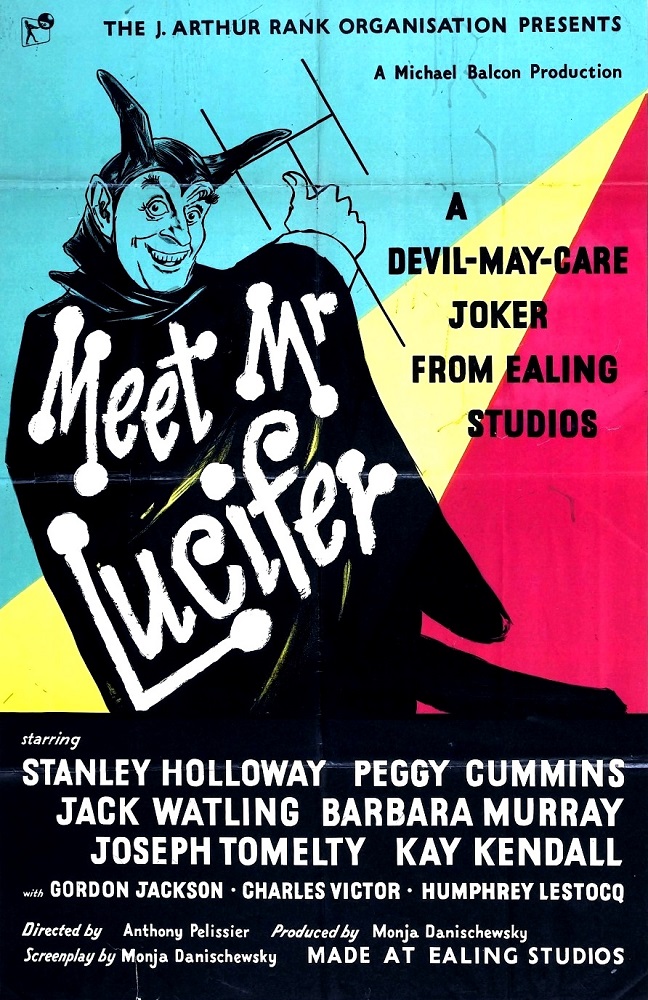Crew
Director – Anton Pelissier, Screenplay/Producer – Monja Danischewsky, Additional Screenplay Material by Alec Graham & Peter Myers, Based on the Play Beggar My Neighbour by Arnold Ridley, Photography (b&w) – Desmond Dickinson, Music – Eric Rogers, Music Supervisor – Dock Mathieson, Special Processes – Geoffrey Dickinson, Special Effects – Sydney Pearson, Makeup – Harry Frampton & H. Wilton, Art Direction – Wilfred Shingleton. Production Company – Ealing.
Cast
Stanley Holloway (Hollingsworth/The Devil), Jack Watling (Jim Norton), Joseph Tomelty (Mr Pedelty), Gordon Jackson (Hector McPhee), Peggy Cummins (Kitty Norton), Barbara Murray (Patricia Pedelty), Jean Cadell (Mrs MacDonald), Kay Kendall (The Lonely Hearts Singer)
Plot
The actor Hollingsworth is playing the role of The Devil in a pantomime version of ‘Robinson Crusoe’. Irritated with indifferent audiences who have switched to television, he gets drunk. Suffering from a hangover the next day, he bangs his head on the trapdoor just as he is about to appear on stage. He wakes up in Hell and meets The Devil who tells him that he invented television to make people miserable and wants Hollingsworth’s help in promoting it. Helping install a tv set in a London suburb, Hollingsworth gets to watch the chaos and frustration the set causes as it passes through the hands of various owners. The recently laid-off accountant Pedelty finds that having a television makes him the hit of the neighbourhood social scene but also causes his bills to mount to more than he can pay. Jim Norton is trying to study for job qualifications when his wife Kitty inherits the tv and its constant blaring drives him to distraction. His frustration ends up accidentally pushing him into the arms of another woman. When the bad-tempered Hector McPhee is left the tv, he becomes entranced by a performer known as the Lonely Hearts Singer and this causes him to suddenly start being nice to people. However, when it is announced that the Lonely Hearts Singer is going to leave, Hector becomes despondent and bad-tempered again.
Ealing Studios had a great deal of success in post-War Britain. The Ealing name soon became synonymous with a series of droll comedies that are nowadays regarded as classics. These include the likes of Kind Hearts and Coronets (1949), Passport to Pimlico (1949), The Lavender Hill Mob (1951), The Man in the White Suit (1951) and The Ladykillers (1955). Meet Mr Lucifer is one of the also-rans among these – it certainly never attained the classic status of any of the other aforementioned and is one Ealing film that has been largely forgotten today.
Despite the Ealing name, Meet Mr Lucifer is never more than a weak-kneed morality play. It is made in the British burlesque tradition and gets by with a certain buoyant sense of humour and some snappy trade-offs but little more than that. Some nice performances keep the proceedings afloat – a young Gordon Jackson is good, playing with blustery bursts of Scottish accent alternated with winsome longing; Barbara Murray has a nice chirpiness; and Kay Kendall is surprisingly plaintive as the Lonely Hearts Singer. On the minus side, Joseph Tomelty’s gold-hearted old duffer and trowel-layered accent quickly wearies one with his donkeyish brayings.
Despite minor moments, the material is exceedingly slight. The fantastic element of The Devil is weakly tied to the plot, while the film’s representations of Hell are cheaply presented. Although the idea of a musical Robinson Crusoe that we see being performed at the beginning of the film, which now involves a female Crusoe and a Black-and-White Minstrel Show version of Friday, as well as appearances from The Devil and tinsel fairies, is an appealing one that would certainly have been more interesting than anything the film has on offer.

Perhaps the most amusing aspect of Meet Mr Lucifer is its obvious subtext about the evils of television. Meet Mr Lucifer came out just at the time when commercial television was becoming widespread and surely shows some ill feeling on the part of filmmakers towards the challenge presented to their traditional domain by the new medium. Certainly, commercial television had been broadcast in England from as far back 1929 but this was only for a few hours a day and signals did not reach outside of London, while for much of the 1930s there were only a few hundred television sets owned in the entire country. Broadcast was suspended in 1939 because it was believed that broadcast antenna would act as targets for German bombers during the Blitz. It was when broadcast resumed in 1946 that television as we know it today with regular shows, dramas, soap operas and news broadcasts began to take off in the UK.
Of course, as filmmakers across the Atlantic suddenly realized around the same time, audiences were abandoning cinema seats for the ease of being able to watch things in their own home and cinema ticket sales plummeted dramatically as a result. This new challenge produced a certain amount of sour grapes from filmmakers. In the US, the same year as Meet Mr Lucifer, Arch Oboler made The Twonky (1953) about a tv set that becomes artificially intelligent and takes over a man’s life, while here tv is seen to be the tool of The Devil designed to make people’s lives miserable.
It is amusing to see some of the notions of how tv was regarded at the time – like how owning a set becomes a sudden locus of social activity where everybody in the neighbourhood would want to come over to see it. The end of Meet Mr Lucifer amusingly has The Devil giving up on television and deciding the new fad to climb aboard is 3-D, which cinema had just started to experiment with the previous year with Oboler’s Bwana Devil (1952) in the hope of providing something that tv lacked.
Anthony Pelissier was a minor director of the era. He had previously made an adaptation of H.G. Wells’ The History of Mr. Polly (1949) and The Rocking Horse Winner (1949) where a boy gains the ability to predict winning horses at the track.
Trailer here
Full film available here


